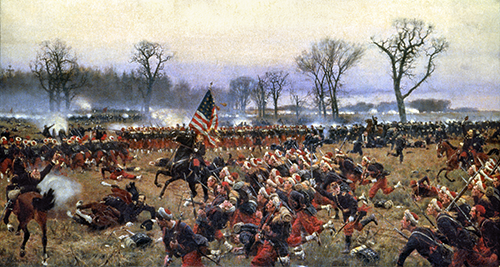Dressed to Kill
Dressed to Kill
By Ephriam D. Dickson III
Deputy Chief, Field Museums Branch, U.S. Army Center of Military History
.png)
Corporal Bradley’s Zouave uniform jacket.
Among the many historical artifacts preserved at the U.S. Army’s Museum Support Center at Fort Belvoir, Va., is the distinctive Civil War uniform of Corporal Matthew Bradley. Born in Yorkshire, England, Bradley immigrated to the United States as a boy, his family ultimately settling in Philadelphia. In August 1862, at the age of 25, he enlisted in Company F of the 114th Pennsylvania Volunteer Infantry, informally known as “Collis’ Zouaves.”
Modeled after the French colonial light infantry, the distinctive uniform of the Zouaves set them apart on the battlefield. Private Bradley’s uniform includes a red fez with a yellow tassel, a short collarless jacket, ballooning red trousers, and white canvas leggings. His jacket is especially well made, neatly hand-sewn from dark blue wool cloth, with sky blue cuffs. Inside the sleeve one can still see two large painted dots―the uniform sizing symbols used by the Schuylkill Arsenal in Philadelphia. During the Civil War, this 12-acre facility was one of the Army’s important centers of manufacture for a wide range of uniforms and footwear. Thousands of women―many the wives of absent Soldiers―worked from their homes to sew together Army uniforms that they brought to the Schuylkill Arsenal for inspection and payment.
Private Bradley’s regiment proudly wore the uniform throughout the Civil War. During the second day of the Battle of Gettysburg, the 114th Pennsylvania advanced across Emmitsburg Road near the Sherfy farmhouse, just north of the Peach Orchard, where they encountered stiff resistance as the Confederate Army advanced. Sergeant Alexander W. Given, also of Company F, recalled,“Then began a desperate conflict, men of both armies clubbing each other with their muskets.” Sergeant Given remembered Private Bradley being “in the thick of the fight.” As the Confederates moved up an artillery battery and fired canister into their ranks, the Zouaves’ defensive line was finally forced back. The regiment suffered heavy casualties in the fighting, with 95 men killed or wounded and 60 reported missing. According to a family descendant, Matt Bradley later joked that he survived because of his small stature, the bullets just passing harmlessly over his head.

Soldiers wearing Zouave uniforms as depicted in The Battle of Fredericksburg, December 13, 1862, by Carl Rochling. The Granger Collection, New York.
Private Bradley served with Company F for the remainder of the war, his unit seeing additional fighting in Grant’s Overland Campaign―the Wilderness, Spotsylvania Court House, North Anna River, and Cold Harbor. A month after the war ended, Bradley was promoted to corporal and proudly sewed on the red stripes still visible on his jacket. Four weeks later, he was mustered out on May 29, 1865.
After the war, Bradley resumed normal life. He married, raised a family, and worked as a plumber and pipe fitter in Philadelphia. In 1886, the 49-year-old veteran returned to Gettysburg with some of his old comrades to dedicate a monument to their beloved regiment, marking the fateful spot near the Sherfy farmhouse where they had once stood. That monument can still be seen today, topped with a large bronze statue of a Zouave reloading his musket, wearing the elaborate and colorful uniform that made them such a distinctive element of the U.S. Army.
This story is courtesy of The Army Historical Foundation and the National Museum of the United States Army, armyhistory.org.


